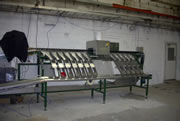Alternatives to Manual Sorting Using Selected Electronic Graders in Asparagus Fresh Packing Sheds: A Cost-Benefit Analysis
by Trent Ball and Raymond Folwell*
 Copy of EB1958 in pdf format may be downloaded here.
Copy of EB1958 in pdf format may be downloaded here.
In the United States (U.S.), nearly 80% of asparagus consumption is fresh product. To optimize the shelf-life of fresh asparagus for the consumer, the grading, sorting, packing, and cooling in an asparagus fresh packing firm must be done rapidly and efficiently. Asparagus is a highly perishable crop, with a shelf life of 3 weeks after harvest under optimum conditions (Robinson et al., 1975).

The current method of handling asparagus in most domestic fresh packing firms is unchanged from the methods used in the 1950s. The methods include extensive hand labor, which is required to visually sort, grade, and orient spears that are bundled and marketed. If this is to be done efficiently, it requires a high-speed evaluation of approximately 0.5 second for each spear (Rigney et al., 1992).
The fast inspection of a large number of spears becomes demanding on a manual grader’s consistency. Further, the intense concentration by manual graders and long hours in a fresh packing firm can cause fatigue and reduce performance (Yang, 1992). Quality of the final product deteriorates as defects are missed, and the precision of bunching by size is reduced. The use of automated systems for grading asparagus could increase productivity along with improved quality in the grading.
In this study, selected electronic graders are evaluated based on a cost-benefit analysis compared with the current system. The objective is to evaluate the substitution of asparagus grading technology for manually grading asparagus spears in a typical domestic fresh packing firm. Individual packing firms must analyze such technologies to determine if the machines can be inserted into their respective facilities based on size requirements. This study will focus on comparisons from an economic perspective among the current method of packing fresh asparagus in the U.S. with electronic grading.



Grader, to the left, Sorter, in the middle, and asparagus pyramid on the right.
*Trent Ball is an Associate in Research, working with Dr. Ray Folwell, on the asparagus project. In November 2001, he traveled to New Zealand to study the asparagus industry there, and traveled to California to study asparagus production in June 2003.
Secondary content using h2 tag.
Lorem ipsum dolor sit amet, consectetur adipisicing elit, sed do eiusmod tempor incididunt ut labore et dolore magna aliqua. Ut enim ad minim veniam, quis nostrud exercitation ullamco laboris nisi ut aliquip ex ea commodo consequat. Duis aute irure dolor in reprehenderit in voluptate velit esse cillum dolore eu fugiat nulla pariatur. Excepteur sint occaecat cupidatat non proident, sunt in culpa qui officia deserunt mollit anim id est laborum.
Heading using the h3 tag
Lorem ipsum dolor sit amet, consectetur adipisicing elit, sed do eiusmod tempor incididunt ut labore et dolore magna aliqua. Ut enim ad minim veniam, quis nostrud exercitation ullamco laboris nisi ut aliquip ex ea commodo consequat. Duis aute irure dolor in reprehenderit in voluptate velit esse cillum dolore eu fugiat nulla pariatur. Excepteur sint occaecat cupidatat non proident, sunt in culpa qui officia deserunt mollit anim id est laborum.